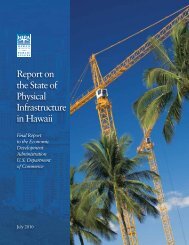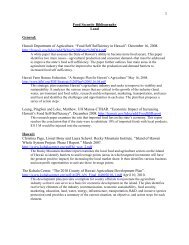Hawai'i Fisheries Initiative - The Hawaii Institute for Public Affairs
Hawai'i Fisheries Initiative - The Hawaii Institute for Public Affairs
Hawai'i Fisheries Initiative - The Hawaii Institute for Public Affairs
Create successful ePaper yourself
Turn your PDF publications into a flip-book with our unique Google optimized e-Paper software.
Troll and Handline<br />
Pelagic <strong>Fisheries</strong><br />
n <strong>The</strong> handline fleet targets yellowfin and<br />
bigeye tuna.<br />
n Trollers, including charter boats, target tuna and<br />
other pelagics such as mahimahi, ono, and billfish.<br />
n Combined annual revenues average $9 million.<br />
n In 2004, trolling yielded 3.1 million pounds<br />
(14 percent of the year’s total harvest)<br />
n Tuna handlining yielded 1.9 million pounds<br />
(8 percent)<br />
n Aku pole-and-line fishery brought in<br />
578,171 pounds in 2004, or 3 percent of<br />
the total catch. 299<br />
History and Status of the<br />
Bottomfish Fishery<br />
Bottomfish are found on the deep outer<br />
reef slopes, banks, and seamounts of the<br />
<strong>Hawaii</strong>an Archipelago. <strong>The</strong> stock complex<br />
includes 19 species, with the “deep seven” –<br />
opakapaka (pink snapper), onaga (long tail<br />
red snapper), ehu (short tail red snapper),<br />
hapu‘upu‘u (<strong>Hawaii</strong>an grouper), kalekale<br />
(Von Siebold’s snapper), gindai, and lehi<br />
(ironjaw snapper) 300 – receiving the most<br />
attention. Handlining, with hydraulic or<br />
electric powered gear, is the preferred<br />
fishing method. 301 In 2004, the total<br />
bottomfish harvest was 612,392 pounds.<br />
Recently, several important issues relating<br />
to bottomfishing and the health of the MHI<br />
stock complex have come to a head.<br />
Bottomfish provide a “lucrative market<br />
niche,” according to Wespac. Demand <strong>for</strong><br />
bottomfish is particularly high during Asian<br />
holidays, as the brightly colored fish are<br />
harbingers of good <strong>for</strong>tune. Foreign imports<br />
of bottomfish fill one-third of the bottomfish<br />
market in Hawai‘i. 302 In 2000, 590,000 pounds<br />
of bottomfish were landed commercially in<br />
the MHI, and 270,000 in the NWHI, with<br />
the total catch bringing in $2.55 million.<br />
DAR offers that once revenues from<br />
fish sales to retailers, restaurants, hotels,<br />
and consumers, plus revenues from the<br />
fishing fleet (fuel, ice, supplies, etc.), the<br />
value of the bottomfish fishery, as with all<br />
commercial fishing activity, is significantly<br />
higher than its ex-vessel value. 303<br />
Wespac manages the stock via its Bottomfish<br />
and Seamount Groundfish FMP, which was<br />
established in 1986. Historically, the council<br />
focused its attention on the NWHI, leaving<br />
bottomfish management in the MHI to the<br />
state because it was thought that 80 percent<br />
of MHI bottomfish habitat was in state<br />
waters (the 0-3 nm zone). However, recent<br />
mapping ef<strong>for</strong>ts show bottomfish habitat as<br />
being fairly evenly divided between state<br />
and federal waters in the MHI. 304<br />
MHI bottomfish catch rate records show<br />
steady declines since the early 1950s,<br />
dropping steeply in the last decade or<br />
so. 305 In 1988, NMFS scientists reported that<br />
66







